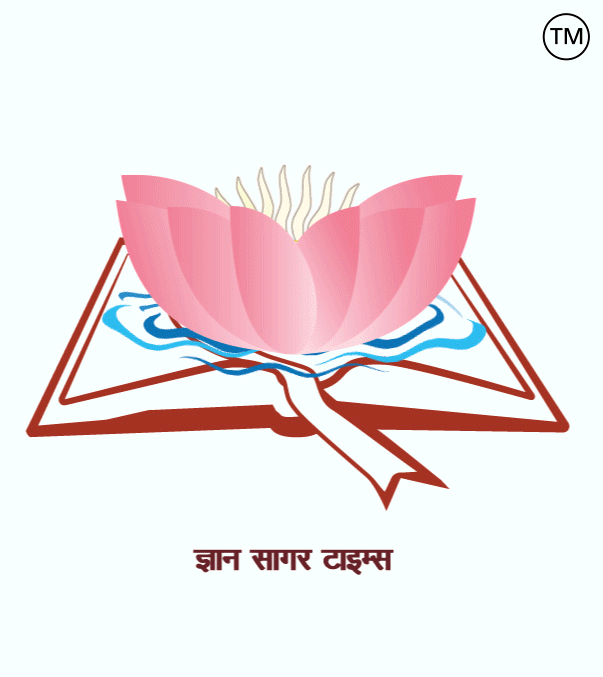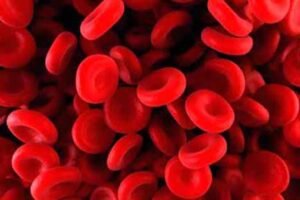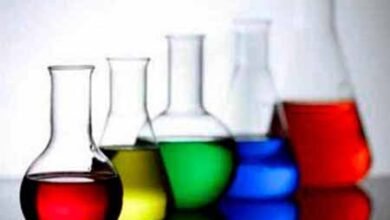
|
1. What is Corpora quadrizemina? =It is the part of the posterior side of the midbrain composed of four colliculi. 2. What is respiration? =Respiratory activity is the exchange of CO2, O2 between the environment, blood and cells. 3. Which structure ensures that the air enters the respiratory tract and the food goes into the alimentary canal? =The epiglottis. 4. Name of the structure connecting the pharynx and trachea? =Larynx, made up of nine cartilages. 5. The trachea is always open and not painful, why? =Because C-shaped cartilage rings are found in its wall. 6. Where does gaseous exchange occur during respiration? =On the surface of follicles. 7. What is the amount pH of in the blood? = 7. 4 (slightly alkaline). 8. Where does blood form? =In the Bone marrow (in the spleen in fetuses and newborns). 9. What is the amount of blood in a normal person? =Approximately 05 litres. 10. What causes RBC red colour? =Due to a protein called haemoglobin found in it. 11. What are the primary immune cells? =Lymphocyte cells. 12. What are the supporting cells in blood clotting? =Thrombocytes. 13. What percentage of the total population in the world is Rh + ve? =About 85percent. 14. Where is the mitral or bicuspid valve found? =Between the left atrium and ventricle of the heart. 15. When does the sound of lub-dub? = ‘Lub’ sound is caused by the closure of the atrioventricular valves and the ‘dub’ sound is caused by the closure of the semilunar valves. 16. What is Bicirculation circulation? =Blood travels through the heart twice for each complete circuit of the body. 17. Which name is the fluid part of the blood known by? =Plasma. 18. Which blood group has both A and B antigens found on red blood cells? =InAB blood group. 19. What is a leukocyte? =The white blood cells (WBCs) that provide immunity and form in the red bone marrow are called leukocytes. 20. What is an artery? = Those blood vessels that carry blood (usually oxygenated or purified blood) from the heart to different parts of the body are called arteries. 21. What is the cardiac cycle? =The sequence of events that occur during one complete heartbeat at both the contraction (systole) and relaxation (diastole). 22. What is an excretion? =Excretion of nitrogenous waste and other toxic substances. 23. What is the main excretory organ in humans? =Kidney. 24. What is a nephron? =It is a structural and functional unit of the kidney. 25. What is a glomerulus? =A group of capillaries found in the Bowman capsule is called a glomerulus. 26. How much blood is dispensed per minute by the kidneys in humans? =About 1000 – 1200 ml of blood. 27. What is the urinary reflex? =The automatic process that controls the emptying of the urinary bladder. 28. Which part of the central nervous system mainly governs and regulates reflex activities? =Spinal cord. 29. Name of a neurotransmitter? =Acetylcholine. 30. After the kidneys, the next excretory organ is? = Ureter. Dr. (Prof.) Amarendra Kumar. ============= ============ ============ जंतु विज्ञान से संबंधित– 186.
1. कॉर्पोरा क्वाड्रीजेमिना किसे कहते हैं? = मध्य मस्तिष्क चार पिण्डों में विभेदित होता है. इसके प्रत्येक पिण्ड को कार्पोरा क्वाड्रीजेमिना कहते हैं. 2. श्वसन किसे कहते हैं? = पर्यावरण, रक्त एवं कोशिकाओं के बीच CO2, O2 , के विनिमय की क्रिया को श्वसन कहते हैं. 3. कौन-सी संरचना यह सुनिश्चित करती है कि वायु श्वसनली में ही जाये तथा भोजन आहार नली में ही जाये? = घाँटी ढक्कन (एपिग्लॉटिस). 4. ग्रसनी व श्वास नली को जोड़ने वाली रचना का नाम? = कण्ठ. यह नौ (09), उपास्थियों से बना होता है. 5. श्वास नली सदैव खुली रहती है तथा पिचकती नहीं है, क्यों? = क्योंकि इसकी भित्ति में C आकार के उपास्थि के छल्ले पाये जाते हैं. 6. श्वसन के दौरान गैसीय विनिमय कहाँ होता है? = कूपिकाओं की सतह पर. 7. रक्त में pH की कितनी मात्रा होती है? = 7. 4 (हल्का क्षारीय). 8. रक्त का निर्माण कहाँ होता है? = अस्थि मज्जा में (भ्रूणावस्था व नवजात शिशुओं के प्लीहा में). 9. एक सामान्य व्यक्ति में रक्त की कितनी मात्रा होती है? = लगभग 05 लीटर. 10. RBC का लाल रंग किस कारण होता है? = उसमें पाये जाने वाले हिमोग्लोबिन नामक प्रोटीन के कारण. 11. प्रतिरक्षा प्रदान करने वाली प्राथमिक कोशिकाएँ कौन सी होती हैं? = लिम्फोसाइट कोशिकाएं. 12. रक्त का थक्का जमाने में सहायक कोशिकाएं कौन सी होती हैं? = बिम्बाणु या थ्रोम्बोसाइट. 13. विश्व में कुल कितनी प्रतिशत आबादी Rh + ve? = लगभग 85 प्रतिशत. 14. माइट्रल या द्विवलन कपाट कहां पाया जाता है? = बायें आलिंद व निलय के बीच में. 15. लब-डब की आवाज कब आती है? = आलिंद-निलय कपाटों (माइट्रल व त्रिलवन कपाटों) के बंद होने पर लब ध्वनि आती है तथा अर्धाचन्दाकार कपाटों के बंद होने पर डब ध्वनि आती है. 16. द्विसंचरण परिसंचरण किसे कहते हैं? = रक्त को एक परिसंचरण चक्र पूरा करने हेतु हृदय में से होकर दो बार गुजरना पड़ता है इसे द्विसंचरण कहते हैं. 17. रक्त के द्रव भाग को किस नाम से जाना जाता है? = प्लाज्मा. 18. किस रक्त समूह में लाल रक्त कणिकाओं पर A एवं B दोनों ही प्रतिजन पाये जाते हैं? = AB रक्त समूह में. 19. ल्यूकोसाइट किसे कहते हैं? = प्रतिरक्षा प्रदान करने वाली एवं लाल अस्थिमज्जा में बनने वाली श्वेत रक्त कणिकाओं (WBC) को ही ल्यूकोसाइट कहते हैं. 20. धमनी किसे कहते हैं? = वे रक्त वाहिनियां जो रक्त को (प्राय: आक्सीजनित या शुद्ध रक्त) हृदय से शरीर के विभिन्न भागों को पहुंचाती है, उन्हें धमनी कहते हैं. 21. हृदय चक्र किसे कहते हैं? = हृदय के एक स्पन्दन प्रारंभ होने से लेकर अगले स्पन्दन के प्रारंभ होने तक हृदय के विभिन्न भागों में होने वाले परिवर्तनों के क्रम को हृदय चक्र कहते हैं. 22. उत्सर्जन किसे कहते हैं? = नाइट्रोजन युक्त अपशिष्ट पदार्थों को शरीर से बाहर निकालने की क्रिया को उत्सर्जन कहते हैं. 23. मनुष्य में मुख्य उत्सर्जी अंग कौन-सा होता है? = वृक्क (Kidney). 24. वृक्काणु या नेफ्रोन (nephron ) किसे कहते हैं? = वृक्क की संरचनात्मक एवं क्रियात्मक इकाई को वृक्काणु कहते हैं. 25. ग्लोमेरूलस किसे कहते हैं? = बोमेन सम्पुट में पाये जाने वाले केशिकाओं के गुच्छे को ग्लोमेरूलस कहते हैं. 26. मनुष्य में वृक्कों द्वारा प्रति मिनट कितने रक्त का निस्पंदन किया जाता है? = लगभग 1000 – 1200 ml रक्त का. 27. मूत्रण प्रतिवर्त किसे कहते हैं? = मूत्रण को सम्पन्न करने वाली तंत्रिका को मूत्रण प्रतिवर्त कहते हैं. 28. प्रतिवर्ती क्रियाओं का संचालन एवं नियमन मुख्यतः केन्द्रीय तंत्रिका तंत्र का कौन सा भाग करता है? = मेरुरज्जू. 29. एक न्यूरोट्रांसमीटर का नाम? = एसेटिलकोलिन (Acetylcholine). 30. किडनी के बाद दुसरा उतसर्जि अंग कौन है? = मूत्रवाहिनी (Ureter).
Dr. (Prof.) Amarendra Kumar. |






